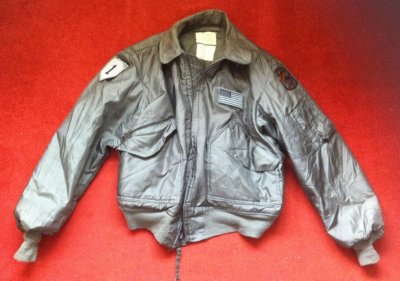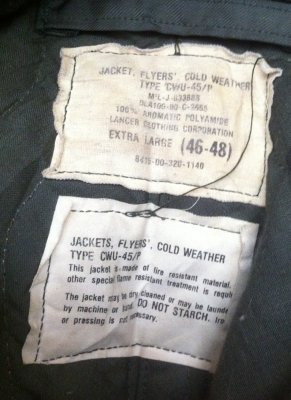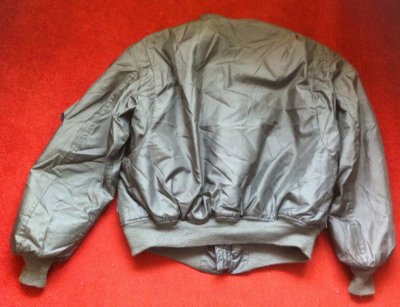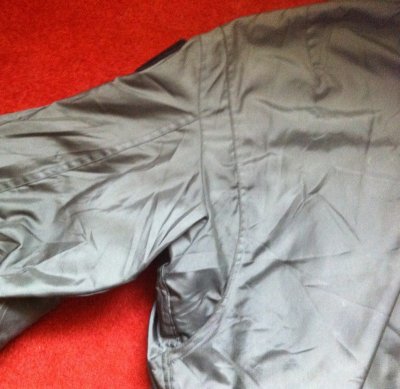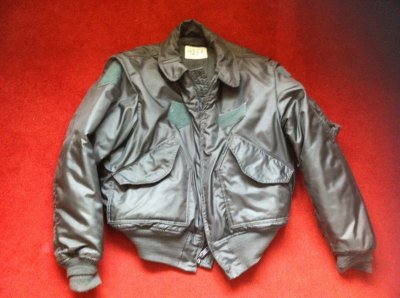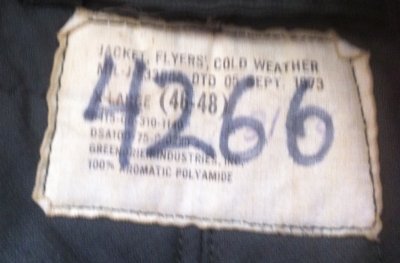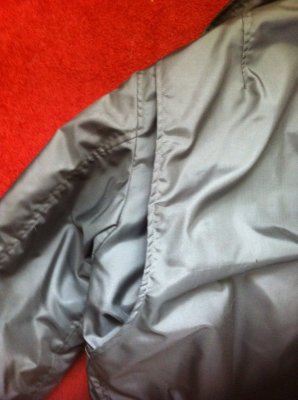Want to buy or sell something? Check the classifieds
-
The Fedora Lounge is supported in part by commission earning affiliate links sitewide. Please support us by using them. You may learn more here.
You are using an out of date browser. It may not display this or other websites correctly.
You should upgrade or use an alternative browser.
You should upgrade or use an alternative browser.
Nomex Flyer jacket
- Thread starter calderoni
- Start date
Doctor Damage
I'll Lock Up
- Messages
- 4,370
- Location
- Ontario
Two of them shall be moved onwards, since they don't fit well. I like the old bi-swing ones, but I find them hit-or-miss in terms of fit and construction. The newer ones are more consistent and easier to clean. I think the Valley ones are the best made by far.bn1966 said:That's a good Nomex collection you've built up there Doc, must admit to liking the early bi-swing models best
Last edited:
Doctor Damage
I'll Lock Up
- Messages
- 4,370
- Location
- Ontario
Doctor Damage
I'll Lock Up
- Messages
- 4,370
- Location
- Ontario
Doctor Damage
I'll Lock Up
- Messages
- 4,370
- Location
- Ontario
I just got one of those CWU 106/P jackets which you commented on. This one is used, but it has only one small pinprick hole in the shell. It should make a good raincoat, which I don't have. Here's what the seller said about these new jackets in an email to me when I expressed my surprise at how different these are from the usual nomex CWU flyers jackets:Treetopflyer said:Those are the new issued jackets. They are very stiff, but great for cold wet weather. I didn't realize the cost was so high for them. They have actually been around for a while in the Navy rotary wing community but due to budgetary issues they were not purchased. Now that the Nomex jackets are leaving the supply system, these new gortex jackets are taking their place. The pants that go with them are also good for cold wet weather. I am not a big fan of the hood that is built into the jacket.
They ARE very different jackets, because they are focused on a different part of the flight operation - keep aircrew members who must leave the aircraft or service it in virtually any weather condition warm and dry. When used with the mid-weight and/or heavyweight fleece designed for use with them, they fulfill the mission requirements admirably. In temperate but wet weather, the jackets and pants may be worn right over a flight suit and will keep the aircrew member dry and protected. The Kevlar provides that extra bit of protection needed when working in and around aircraft.
Atticus Finch
Call Me a Cab
- Messages
- 2,718
- Location
- Coastal North Carolina, USA
Getting older and not gaining weight is a battle I've totally lost this year. So I've been halfheartedly looking for a fat-boy sized CWU-45P in sage. I have one in desert tan, but it looks like a 1970s disco jacket. I just can't bring myself to wear it in public.
I wanted a sage CWU that is in good condition, not covered in velcro receivers and without ripped seams. Friday, I stumbled across this almost mint one and managed to score it for the opening bid. It wasn't cheap. In the past, I've bought nice nomex jackets on ebay for as little as 99 cents. This one dang sure set me back more than that. Still, I'm hoping it will get a lot of wear this winter. Maybe by next year I'll be a bit smaller and will be able to get back into my vintage nylon.
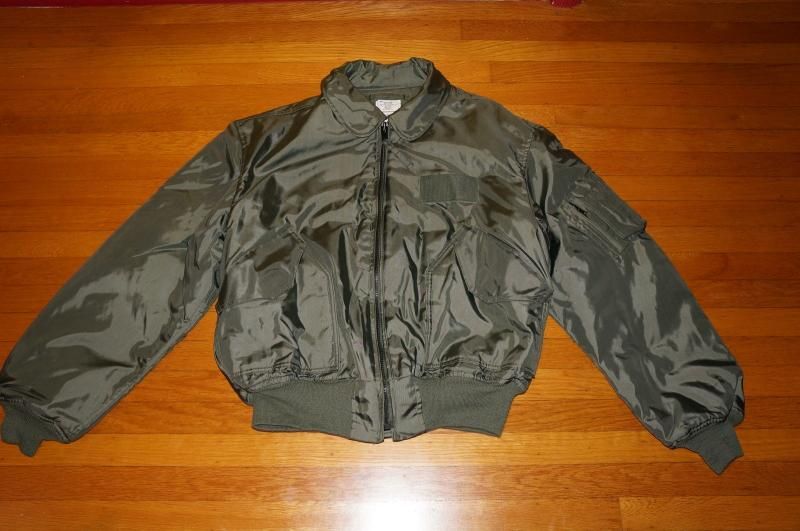
AF
I wanted a sage CWU that is in good condition, not covered in velcro receivers and without ripped seams. Friday, I stumbled across this almost mint one and managed to score it for the opening bid. It wasn't cheap. In the past, I've bought nice nomex jackets on ebay for as little as 99 cents. This one dang sure set me back more than that. Still, I'm hoping it will get a lot of wear this winter. Maybe by next year I'll be a bit smaller and will be able to get back into my vintage nylon.

AF
Have just scored a 'Cold Weather' Greenbrier '73/75? that should arrive sometime in the next two weeks (stated as having 'minor wear'...could be interesting), it does unfortunately have a small hole in the back of the shell that will need repairing...but for the year I thought it worth a punt.
Attachments
-
 clients-kcpicker211-photo_sets-73296-thumbs_IMG_7029.JPG16.7 KB · Views: 526
clients-kcpicker211-photo_sets-73296-thumbs_IMG_7029.JPG16.7 KB · Views: 526 -
 clients-kcpicker211-photo_sets-73296-thumbs_IMG_7031.JPG17.1 KB · Views: 462
clients-kcpicker211-photo_sets-73296-thumbs_IMG_7031.JPG17.1 KB · Views: 462 -
 clients-kcpicker211-photo_sets-73296-thumbs_IMG_7032.JPG16.9 KB · Views: 478
clients-kcpicker211-photo_sets-73296-thumbs_IMG_7032.JPG16.9 KB · Views: 478 -
 clients-kcpicker211-photo_sets-73296-thumbs_IMG_7033.JPG15.3 KB · Views: 482
clients-kcpicker211-photo_sets-73296-thumbs_IMG_7033.JPG15.3 KB · Views: 482
Last edited:
Doctor Damage
I'll Lock Up
- Messages
- 4,370
- Location
- Ontario
I hope your jacket turns out to be a good one, minor flaws notwithstanding, and it looks like Atticus got lucky with an unworn coat. Incidentally, I can claim with experience in a Canadian winter that the old 1970s bi-swing 45/P jackets are warmer than the newer ones from the 1990s and 2000s. I had earlier in this thread speculated the old jackets might have a cotton layer as part of the insulation based on photos of a torn-up jacket which I posted, which, if true, would help with wind resistance. I have found the newer jackets have almost no wind resistance. Also, the nomex shell on the old jackets is thinner but tighter weave, which would also help. The insulation is the same thickness in the old and new jackets, so it's the wind resistance which is the issue.
Very interesting Doc, my 2000 Propper (now on eBay) didn't feel very warm or wind resistant. Hopefully this one if it's OK will be warmer. On the label it states a 'DTO' of 5th Sept 1973 & a DSA of 75. I take it 75 would have been date of manufacture?? Can anyone clear that up for me?
Doctor Damage
I'll Lock Up
- Messages
- 4,370
- Location
- Ontario
I've seen several go by over the past few months with that tag. Greenbrier seems to have made a ton of jackets in 1973/1975 and of course 1978 and 1979. I haven't seen any 45/P tags until the 1990s, under the new patterns. I wonder if the USAF didn't issue them too much or they had so many they didn't need more made for several years? I realize that doesn't answer your question.bn1966 said:Very interesting Doc, my 2000 Propper (now on eBay) didn't feel very warm or wind resistant. Hopefully this one if it's OK will be warmer. On the label it states a 'DTO' of 5th Sept 1973 & a DSA of 75. I take it 75 would have been date of manufacture?? Can anyone clear that up for me?
CWU 45/P 1980 Lancer Clothing Corp in 46/48 just added to collection..complete with 'Action Pleats' & in a darker shade of green than most modern CWU's. Fit is short, nomex soft in comparison to later units. Action pleats are more subtle than the Greenbrier as shown by comparing the two. Jacket is in remarkable condition for the year and has no issues at all.
Attachments
Last edited:
CWU 45/P 1975 Greenbrier size 46/48 the second CWU jacket that's arrived this week. Great Bi-swing back action, again very short..more tailored than some later versions and in a similar shade to the Lancer. Needs a small hole on shell darned but given the year it's a very clean jacket. Cuffs showing some wear, but give a nice relaxed fit on so I will probably leave them as is. Wore this unit out in the cold yesterday and it performed well.
Attachments
Doctor Damage
I'll Lock Up
- Messages
- 4,370
- Location
- Ontario
Excellent looking jackets and I'm pleased you found not just one, but two, oldies in size XL, and in good condition. Incidentally, I like the looser knits at the wrist on old jackets; I find the knits on new ones from the past couple decades too tight for comfort.
Below is a link to a USN document which describes, among other items of protective clothing, the G-1, 36/P, 45/P, and 106/P flyer jackets. It's a PDF and it's big in size (15 MB) but worth downloading and reading.
LINK
Below is a link to a USN document which describes, among other items of protective clothing, the G-1, 36/P, 45/P, and 106/P flyer jackets. It's a PDF and it's big in size (15 MB) but worth downloading and reading.
LINK
Thanks Doc,
Both are very good wearers and very practical for the current colder weather over here. The pair are purchases from the USA, not much vintage stuff crops up in the CWUs in the UK. Just sold my modern 45/P (Propper) today which the oldies are intended to replace.
Thanks for the USN link, will have a good peruse of that.
Both are very good wearers and very practical for the current colder weather over here. The pair are purchases from the USA, not much vintage stuff crops up in the CWUs in the UK. Just sold my modern 45/P (Propper) today which the oldies are intended to replace.
Thanks for the USN link, will have a good peruse of that.
Doctor Damage
I'll Lock Up
- Messages
- 4,370
- Location
- Ontario
The oldies are nicer than the new ones, of course, but not light-years better. I wouldn't mind another.bn1966 said:Both are very good wearers and very practical for the current colder weather over here. The pair are purchases from the USA, not much vintage stuff crops up in the CWUs in the UK. Just sold my modern 45/P (Propper) today which the oldies are intended to replace.
If you flip through that document to the section on 45/P jackets they've got instructions -- with diagrams -- on how to replace knits.Thanks for the USN link, will have a good peruse of that.
I've finally figured out (I think) why heavily used 45/P jackets often have worn-out seam stitching on the inside seam of the arms. When you move your arms those seams come into direct rubbing contact with the rearmost edges of the pockets, which on 45/P jackets, being insulated, stick out 1/4". Of course, general wear to seam stitching occurs all over these jackets depending on what they're subjected to, but the inside sleeve seams seem to be the most commonly damaged from what I've seen listed on the Bay. Just a theory, but it's something I've noticed wearing my own 45/P jackets. The pockets on the 36/P jackets are only a single layer of cloth and don't snag which is why the sleeve seams are intact on all seven of my 36/P jackets of all ages.
Featured products
-
 John Lofgren Monkey Boots Shinki Horsebuttt - $1,136 The classic monkey boot silhouette in an incredibly rich Shinki russet horse leather.
John Lofgren Monkey Boots Shinki Horsebuttt - $1,136 The classic monkey boot silhouette in an incredibly rich Shinki russet horse leather. -
 Grant Stone Diesel Boot Dark Olive Chromexcel - $395 Goodyear welted, Horween Chromexcel, classic good looks.
Grant Stone Diesel Boot Dark Olive Chromexcel - $395 Goodyear welted, Horween Chromexcel, classic good looks. -
 Schott 568 Vandals Jacket - $1,250 The classic Perfecto motorcycle jacket, in a very special limited-edition Schott double rider style.
Schott 568 Vandals Jacket - $1,250 The classic Perfecto motorcycle jacket, in a very special limited-edition Schott double rider style.
Doctor Damage
I'll Lock Up
- Messages
- 4,370
- Location
- Ontario
Freezing rain (literally) on my walk today and I foolishly wore my oldest bi-swing 45/P instead of the new 106/P waterproof. The 45/P got wet but then it became waterproof when a layer of ice formed over the whole jacket. I must have weighed 10 lbs more by the time I got home!
Doctor Damage
I'll Lock Up
- Messages
- 4,370
- Location
- Ontario
Some further comments from that e-Bay seller:I just got one of those CWU 106/P jackets which you commented on. This one is used, but it has only one small pinprick hole in the shell. It should make a good raincoat, which I don't have. Here's what the seller said about these new jackets in an email to me when I expressed my surprise at how different these are from the usual nomex CWU flyers jackets:
They ARE very different jackets, because they are focused on a different part of the flight operation - keep aircrew members who must leave the aircraft or service it in virtually any weather condition warm and dry. When used with the mid-weight and/or heavyweight fleece designed for use with them, they fulfill the mission requirements admirably. In temperate but wet weather, the jackets and pants may be worn right over a flight suit and will keep the aircrew member dry and protected. The Kevlar provides that extra bit of protection needed when working in and around aircraft.
All of the MCPS outerwear items - pants and jackets - are designed to be worn over one or two layers of fleece undergarments. The heavyweight fleece (dark green) may be worn alone under the outerwear, or in extreme cold, may be worn over one or the other of the black underlayers - either heavyweight or midweight fleece, The underlayers are available on eBay at reasonable prices, because many of the aircrews in the lower 48 who use the MCPS normally only use the dark green heavyweight fleece. My nephew is a Navy rescue swimmer and he swears by the MCPS ensemble - in all conditions. He has worn it in temperate, hot and very cold conditions.
Doctor Damage
I'll Lock Up
- Messages
- 4,370
- Location
- Ontario
The other day I finally got the chance to wear one of my CWU 106/P jackets in the rain and it performed well, keeping me 100% dry. The only weird thing was that the front cargo pockets got wet, almost as if they don't have a gore-tex lining. I had my hands stuffed in those pockets which got me a bit worried for the rest of the jacket but when I got home and took it off the torso was totally dry inside. Anyways, a couple hours hanging up and it was dry.
Similar threads
- Replies
- 14
- Views
- 5K
- Replies
- 37
- Views
- 14K
Members online
- Castello
- myopic1
- Bender
- StoryPNW
- Tactics
- navetsea
- dinhnguyen57
- Diamondback
- Debi
- WillyW
- barthestole
- JL0331
- straytray
- Roland Nicholson
- hardlyworkingman
- quikrick
- Gudachi
- Rugby
- Monitor
- Igneous629
- Jiantle
- rodgerrr
- Manu Mohan
- AerGuitar
- voodootomato
- hatsRme
- Khilij
- hd3kmize
- Nousdefions18e
- hms07
- GenoLou
- ParkerFM
- Aladeen's magic carpet
- MichaelV
- codex
- BarryMcCockiner_PhD
- baldfront
- ucla bruin
- Jasonissm
- djdrawsdaily
- V.C. Brunswick
- tonyb
- Luc Punksblood
- dapperdon1
- cbez
- Stacks
- Ai-Phu-Gyu
- drewlesch
- kuwubara
- torfjord
Total: 5,167 (members: 79, guests: 5,088)











